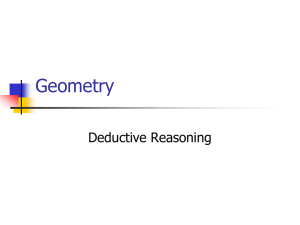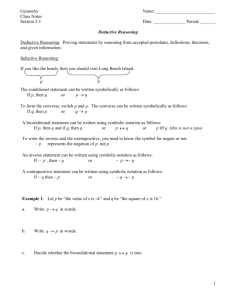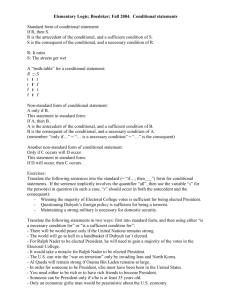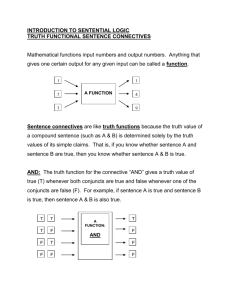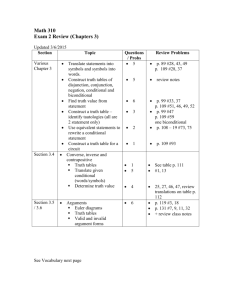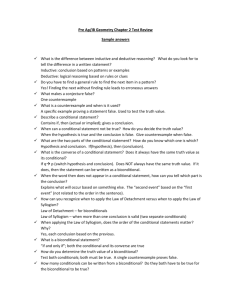Lesson 17
advertisement
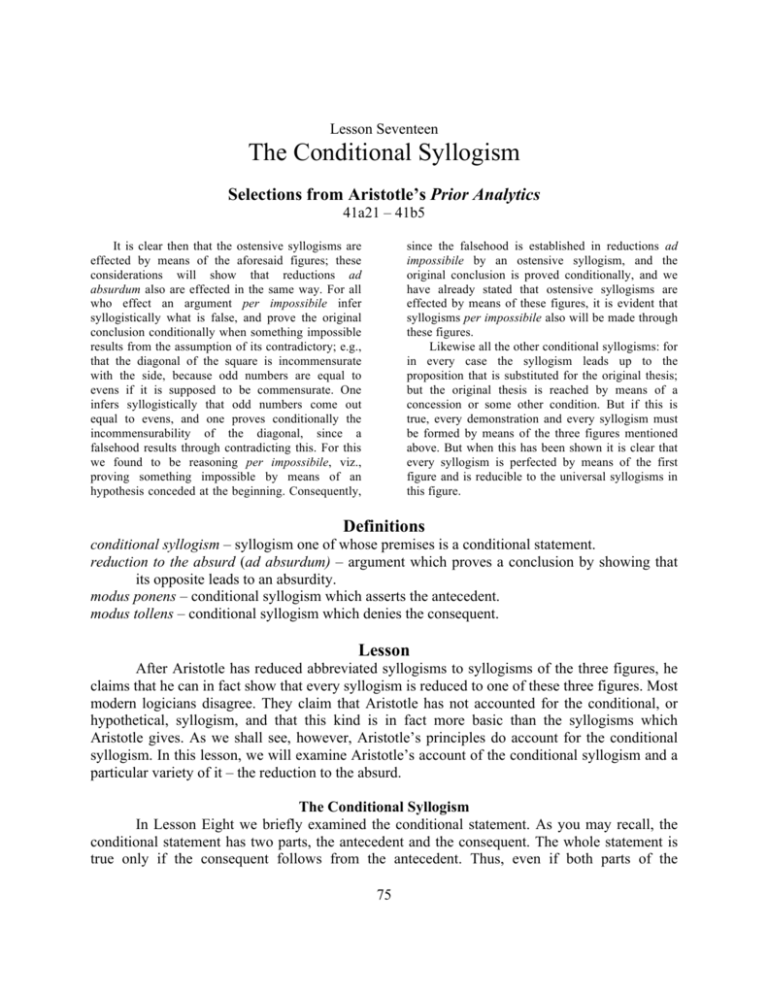
Lesson Seventeen The Conditional Syllogism Selections from Aristotle’s Prior Analytics 41a21 – 41b5 It is clear then that the ostensive syllogisms are effected by means of the aforesaid figures; these considerations will show that reductions ad absurdum also are effected in the same way. For all who effect an argument per impossibile infer syllogistically what is false, and prove the original conclusion conditionally when something impossible results from the assumption of its contradictory; e.g., that the diagonal of the square is incommensurate with the side, because odd numbers are equal to evens if it is supposed to be commensurate. One infers syllogistically that odd numbers come out equal to evens, and one proves conditionally the incommensurability of the diagonal, since a falsehood results through contradicting this. For this we found to be reasoning per impossibile, viz., proving something impossible by means of an hypothesis conceded at the beginning. Consequently, since the falsehood is established in reductions ad impossibile by an ostensive syllogism, and the original conclusion is proved conditionally, and we have already stated that ostensive syllogisms are effected by means of these figures, it is evident that syllogisms per impossibile also will be made through these figures. Likewise all the other conditional syllogisms: for in every case the syllogism leads up to the proposition that is substituted for the original thesis; but the original thesis is reached by means of a concession or some other condition. But if this is true, every demonstration and every syllogism must be formed by means of the three figures mentioned above. But when this has been shown it is clear that every syllogism is perfected by means of the first figure and is reducible to the universal syllogisms in this figure. Definitions conditional syllogism – syllogism one of whose premises is a conditional statement. reduction to the absurd (ad absurdum) – argument which proves a conclusion by showing that its opposite leads to an absurdity. modus ponens – conditional syllogism which asserts the antecedent. modus tollens – conditional syllogism which denies the consequent. Lesson After Aristotle has reduced abbreviated syllogisms to syllogisms of the three figures, he claims that he can in fact show that every syllogism is reduced to one of these three figures. Most modern logicians disagree. They claim that Aristotle has not accounted for the conditional, or hypothetical, syllogism, and that this kind is in fact more basic than the syllogisms which Aristotle gives. As we shall see, however, Aristotle’s principles do account for the conditional syllogism. In this lesson, we will examine Aristotle’s account of the conditional syllogism and a particular variety of it – the reduction to the absurd. The Conditional Syllogism In Lesson Eight we briefly examined the conditional statement. As you may recall, the conditional statement has two parts, the antecedent and the consequent. The whole statement is true only if the consequent follows from the antecedent. Thus, even if both parts of the 75 statements are true, if the second does not follow from the first, the whole statement is false. On the other hand, the whole statement can be true even if one or both of the parts are false, as long as the second follows from the first. We must notice that the conditional statement, according to this explanation, seems very similar to the definition of the syllogism. The syllogism, as you recall, is a complex expression in which, the premises being given, the conclusion necessarily follows from them. In fact, when Aristotle gives the syllogisms, he gives them in the form of conditional statements with two antecedents: “If A belongs to every B, and B belongs to every C, then A also belongs to every C.” This is a sign that the conditional syllogism will be related to the syllogisms in the three figures. We can find clearer evidence of that relation by considering the conditional statement in itself. The consequent must follow from the antecedent in order for the whole statement to be true. But we can only prove that it follows by making a syllogism of one of the three figures, using the antecedent as a premise. We can conclude, then, that the conditional statement is usually just an abbreviated syllogism in which the explicit premise is not asserted, but merely proposed. An example will help to explain what we mean. Take the conditional statement “If man were a plant, he would lack sensation.” If we apply the rules of the abbreviated syllogism, we can see that the conclusion “Every man lacks sensation” follows from the explicit premise “Every man is a plant” and the implicit premise “Every plant lacks sensation.” We see that the conditional is true because the implied syllogism is valid, even though its conclusion is false. In the same way, a conditional statement can be true even if its consequent and antecedent are false. Such a conditional statement still stands as true because it does not assert the antecedent as a truth. Rather, it asserts only that if the antecedent were true, the consequent would follow from it. That men are plants is only supposed; the consequent, men lack sensation, follows from that supposition. A second derivation of the conditional statement, however, occurs when it is substituted for a confusing or elaborate simple universal statement. As we saw before, a statement is simple if the subject and predicate each form an essential unity, no matter how many words they contain. For example, “bodily, living, sensitive, rational substance” is a simple noun because it forms an essential unity, usually signified by the word “man.” The statement “A bodily, living, sensitive, and rational substance is a man” is therefore a simple statement. To express such an elaborate simple statement, however, it is sometimes easier to use a conditional sentence whose subject is the remote genus of the thing being explained. Thus we say that, in the antecedent, the subject has certain properties, and in the consequent, it has other “properties” (e.g., the name of a thing we want to define) which follow from it having the first ones. For example, instead of stating, “Every bodily, living, sensitive, rational substance is a man,” we might find it easier to state, “If a substance is bodily, sensitive, and rational, then it is a man.” In this way we can substitute a conditional statement for a very long and complicated simple statement. The meaning is the same, but the conditional expression is more easily understood. The conditional statement, then, is either 1) an abbreviated syllogism which does not positively assert its explicit premise or 2) a substitute for the universal statement. In either case, the conditional syllogism, of which the conditional statement forms the principle part, follows clear rules. 76 Now, the conditional syllogism has one conditional and one asserting premise, and it comes in two valid moods, called modus ponens (“the way of positing”) and modus tollens (“the way of removing”). The first, modus ponens, works by asserting the antecedent, which was only supposed in the conditional statement. For example, “If man is an animal, then he has sensation. But man is an animal. Therefore, he has sensation” proceeds according to modus ponens. The second, modus tollens, works by denying the consequent and thus denying the antecedent from which it follows. For example, “If man is a plant, then he lacks sensation. But man does not lack sensation, therefore he is not a plant” works by modus tollens. The conditional syllogism is invalid if the consequent is asserted, or the antecedent denied. For example, the statement “If man is a beast, he will have sensation” is true, because the consequent follows from the antecedent. If I were to assert that man is not a beast, it does not follow that man does not have sensation. Similarly, if it is raining, the ground will be wet, but the ground being wet does not imply that it is raining, since the sprinklers can also make the ground wet. Thus, the only two valid moods of the conditional syllogism are modus ponens and modus tollens. The following are the moods of the conditional syllogism: CAUTION: In this chart, X and Y represent propositions, not terms. Conditional Syllogisms Modus Ponens Modus Tollens If X is true, then Y is true. X is true. Therefore, Y is true. If X is true, then Y is true. Y is false. Therefore, X is false. Reduction to the Absurd Reduction to the absurd is a kind of syllogism that proves something true by showing that its contradictory is false. Euclid often uses this method in his books on geometry. Aristotle teaches that the reduction to the absurd uses the conditional syllogism. Here is an example of such a reduction: Either every two lines have a unit that measures both evenly, or some two lines do not have such a unit. If every two lines have such a unit, then the number of times that the unit that measures both the side of the square and its diagonal measures the diagonal is both even and odd. But no number can be both even and odd. Therefore, [by modus tollens] it is false that every two lines have such a unit. Thus, the contradictory, some two lines do not have a common unit, is a true statement. In this example, Aristotle assumes the contradictory of what he wished to prove, using it as the antecedent in the conditional statement. Since the consequent of the conditional is false, the antecedent must also be false, by modus tollens. And, since the antecedent is the 77 contradictory of what he wished to prove, the intended conclusion must be true. Thus, the intended conclusion has been proven by a reduction to absurdity. Since the conditional syllogism reduces to the syllogisms of the three figures, so does the reduction to the absurd. Thus, Aristotle states that every reduction to the absurd can be transformed into a direct proof, that is, into a syllogism of one of the three figures. Also, recall that the reduction of syllogisms by contradiction is an application of the method of reduction to the absurd. Both begin by assuming the opposite of what they intend to prove, and then show that that opposite is false. Exercises Exercise 1: State whether the following syllogisms are valid or invalid. 1. 2. 3. 4. If triangles have angles equal to 180 degrees, then squares have angles equal to 360 degrees. Triangles have angles equal to 180 degrees. Therefore, squares have angles equal to 360 degrees. Should all goods come from virtue, no evil man possesses the good. Some evil men possess the good. Therefore, some goods do not come from virtue. If every triangle has angles equal to 180º, then every square has angles equal to 360º. Every square does have angles equal to 360º. Therefore, every triangle has angles equal to 180º. 5. If mathematics is wisdom, then children can be wise. Children cannot be wise. Therefore, mathematics is not wisdom. 6. Things are in a species when they have an essence. Nothing has an essence. Therefore, nothing is in a species. 7. If some logician is emotional, then some logician is not logical. Every logician is logical. Therefore, no logician is emotional. 8. When cats have nine lives, then they have immaterial souls. Cats have nine lives. Cats have immaterial souls. 9. If a lion is an animal, then it has sensation. Lions are animals. Therefore, lions have sensation. 10. If a square were a circle, it would be a plane figure. The square is not a circle. Therefore, it is not a plane figure. If virtue is knowledge, then virtue is teachable. But virtue is not knowledge. Therefore, virtue is not teachable. 78
